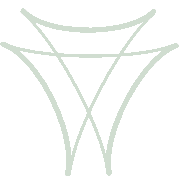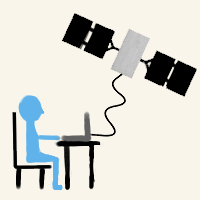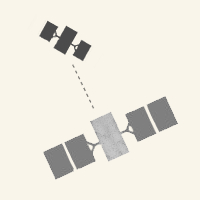Optical payload performance is specified in part by its Optical Transfer Function (OTF) or its Modulation Transfer Function (MTF), which is the magnitude of the OTF. An optical engineer allocates a portion of the system OTF to an Image Motion OTF, from which pointing requirements are derived. There is usually a loss of information, and added confusion, in the translation from an optical system requirement to a spacecraft bus performance requirement. There is then a loose connection between pointing performance and optical payload performance.
Traditional Pointing Requirements: Stability and Jitter
Traditional pointing performance requirements are given in terms "stability" and "jitter", which are known to be very conservative, give inconsistent results, are not indicative of optical payload performance, difficult to analyze in the time domain, and have no mathematical equivalent in the frequency domain. Stability and jitter are inconsistently defined across programs, are open to interpretation, and subject to varying methods of analysis.
In addition, the Line of Sight pointing requirements are often defined at the bus-to-payload interface or at a nominal optical boresight axis fixed externally to the optical payload. Such requirements are not valid for an image motion allocation for the optical sensor, unless the optical sensor is a rigid body at the disturbance frequencies at the interface.
The performance requirements and analysis methodology that I advocate provides a direct connection between the Image Motion OTF and spacecraft bus performance. This methodology is being adopted in industry, NASA, and DoD, particularly on high-performance missions.
Line-of-Sight Pointing Defined
The Point Spread Function (PSF) of an optical sytem is the image of a point source of light. The image of the point source is the impulse response of the optical system. The Line of Sight (LOS) is defined as the location of the maximum of the PSF. In an isoplanactic (linear shift invariant) optical system, image motion is equivalent to PSF motion, or LOS motion.
Wavefront error is the deviation of light energy from a spherical wavefront that causes the image of a point source to be distorted. A structural model provides the Piston, Tip, and Tilt (PTT) displacements of the optical elements, including the focal plane. An optical sensitivity model converts the PTT into wavefront error, from which the PSF is computed. Time-varying PTT causes image motion and varying shape of the PSF.
In situations where an optical model is not available or cannot be provided, a similar design may be available as a temporary proxy, a pinhole camera model may be used provisionally, or disturbance response data can be given to the optical engineers for evaluation.
OTF, MTF, CTF
The OTF is the imaging system's response to a sinusoidally-varying image intensity. The MTF is simply the magnitude of the OTF. The Contrast Transfer Function (CTF) is the optical system's response to alternating black/white line pairs, and is closely related to the MTF. The total system OTF is the product of the OTF due to atmospheric effects (if applicable), the OTF of the optics, the OTF of the detector, and the Image Motion OTF (IM OTF). (Image display OTF and human visual system (HVS) OTF are not considered here.) Image motion reduces the system OTF, particularly at higher spatial frequencies, and reduces the resolution of the optical system. Image motion is potentially a limiting factor in the imaging performance of an optical system.
Image Motion OTF
The Image Motion OTF for various types of image motion are well known. IM OTFs are known for non-random motions such as linear (smear), parabolic (smile), cubic (frown), and harmonic motions. The well known jitter OTF is for Gaussian random motion. The deterministic smear OTF is a sinc function parameterized by the image smear length, which is assumed to be known or limited to some value. The actual image smear length is a mean plus a random smear. Traditionally, a deterministic smear OTF requirement is based on the mean plus 2σ smear length.
Jitter is traditionally assumed to be "high frequency motion" with many cycles during the integration time T of the optical detector and a break frequency at 1/T. However, I have defined a mathematically rigorous definition of jitter and have shown that jitter can be significant at frequencies less than 1/T. It is often assumed that jitter is above the control loop bandwidth, but this is not always true, and in fact modal damping can increase or decrease due to feedback, which affects jitter. The Harmonic OTF will be the subject of a later publication.
The traditional term "stability" is replaced by mathematically rigorous definitions of displacement (shift), smear, and Windowed Stability. There is a displacement OTF, which is just a spatial phase shift of an image, and we can define a displacement covariance. Windowed Stability measures image-to-image registration accuracy.
You can find out more about Image Motion OTFs in my journal article and citations therein:
M. E. Pittelkau and W. G. McKinley, "Optical Transfer Functions, Weighting Functions, and Metrics for Images with Two-Dimensional Line-of-Sight Motion", Optical Engineering, SPIE, Volume 55, Issue 6, June 2016. 18 pages.
DOI: http://dx.doi.org/10.1117/1.OE.55.6.063108 [Open Access]
Statistical Smear OTF
I derived a 2D Statistical Smear OTF, which describes the average performance of an imaging system over an ensemble of images subject to random smear. This is more useful than the deterministic smear OTF when specifying a smear requirement and when analyzing system performance. The statistical smear OTF is parameterized by a mean smear vector and a covariance matrix, which are described under the next subheading.
Image Motion OTF Performance Analysis
The Image Motion OTF is traditionally evaluated by numerical methods. Such methods require a large amount of time-domain simulation data at a high sample rate to capture jitter motion. This is an arduous approach because the integration is over time and two dimensions of spatial frequency. To reduce the computational burden, the OTF is sometimes computed as the product of two one-dimensional OTFs. In general, the Image Motion OTF is not separable in the two coordinate axes, so combining two one-dimensional results is not strictly valid. Although MTF requirements are sometimes written as 1D requirements for motion in x and y axes of the image plane, they cannot be verified by computing two 1D MTFs. There are, however, numerical methods that can be used to compute 2D OTF from time-domain data, but still require a large amount of time-domain simulation data at a high sample rate.
The methodology that I advocate is an effective alternative, or addition, to traditional methods because it is based on frequency-domain data and is much faster to compute. The displacement (shift) OTF, Statistical Smear OTF, and jitter OTF are parameterized by Pointing Performance Metrics (PPM), which are the means and covariances of displacement, smear, and jitter. The PPM are computed from a weighted power spectral density of the of the image motion, where the weighting functions are specific to displacement, smear, and jitter.
Engineering Support for Optical Payload and
Pointing Performance Analysis
The Statistical Image Motion OTFs and related Pointing Performance Metrics are being adopted on many spacecraft programs, particularly where high performance is required. My engineering services include helping you define or interpret Image Motion and Pointing Performance requirements written in terms of Image Motion OTFs or Pointing Performance Metrics (displacement, smear, and jitter). I can provide verification and validation of OTF or MTF results where a customer may not be satisfied with the results.
Contact me if you need engineering support or consultation on image motion and pointing performance requirements and analysis, or to arrange a workshop presentation.
Workshop on Image Motion Optical Transfer Functions and Pointing Performance Analysis
I can present an 8-hour workshop on Optical Transfer Functions and Pointing Performance Analysis to your engineers. The workshop includes a primer on optical system performance, methods to evaluate the Image Motion OTFs, a discussion of image motion and pointing requirements, techniques to evaluate Pointing Performance Metrics that parameterize the Image Motion OTFs, and the relative and cumulative contribution analysis.
Copyright © 2021 by Mark E. Pittelkau and Aerospace Control Systems, LLC



